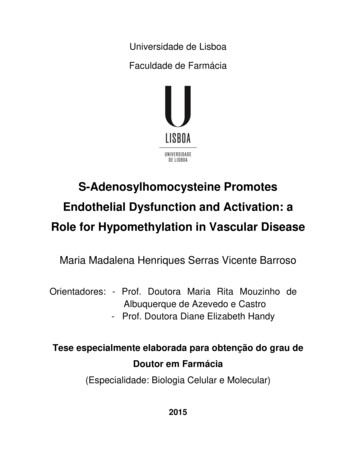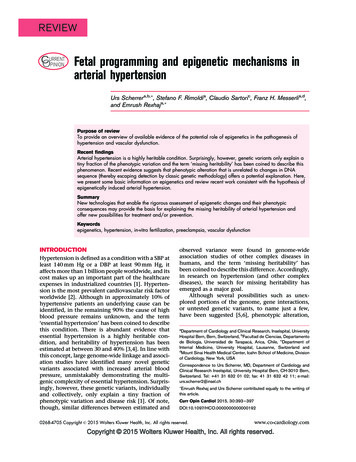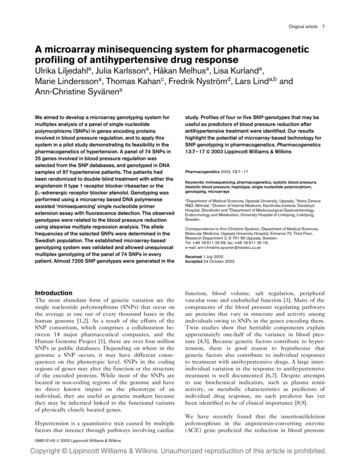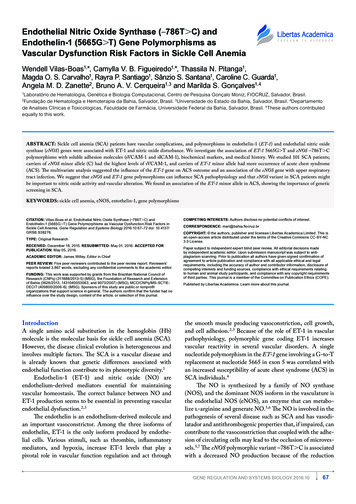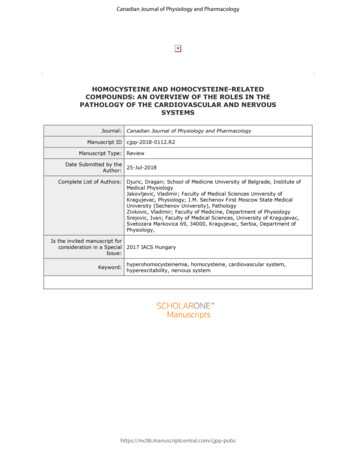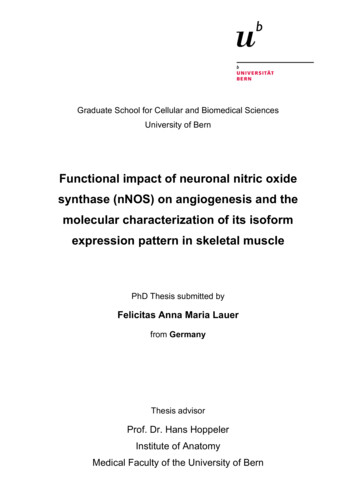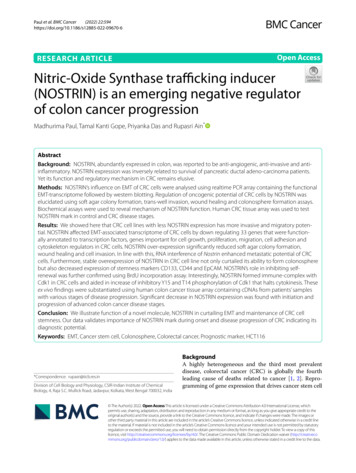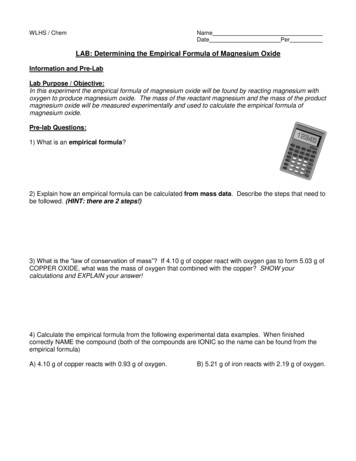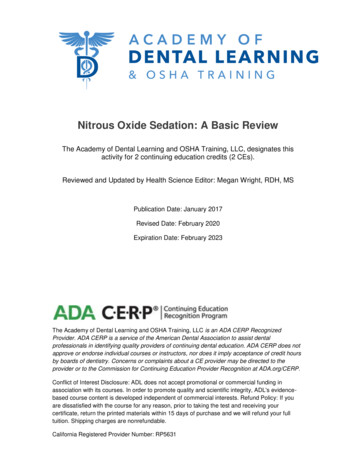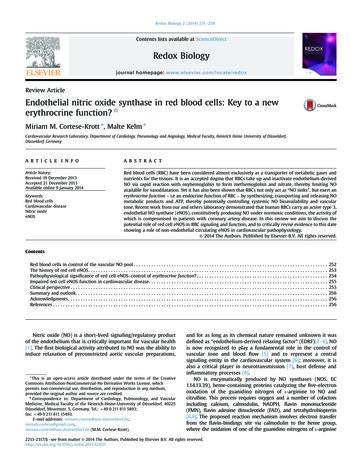
Transcription
Redox Biology 2 (2014) 251–258Contents lists available at ScienceDirectRedox Biologyjournal homepage: www.elsevier.com/locate/redoxReview ArticleEndothelial nitric oxide synthase in red blood cells: Key to a newerythrocrine function? Miriam M. Cortese-Krott n, Malte Kelm nCardiovascular Research Laboratory, Department of Cardiology, Pneumology and Angiology, Medical Faculty, Heinrich Heine University of Düsseldorf,Düsseldorf, Germanyart ic l e i nf oa b s t r a c tArticle history:Received 19 December 2013Accepted 21 December 2013Available online 9 January 2014Red blood cells (RBC) have been considered almost exclusively as a transporter of metabolic gases andnutrients for the tissues. It is an accepted dogma that RBCs take up and inactivate endothelium-derivedNO via rapid reaction with oxyhemoglobin to form methemoglobin and nitrate, thereby limiting NOavailable for vasodilatation. Yet it has also been shown that RBCs not only act as “NO sinks”, but exert anerythrocrine function – i.e an endocrine function of RBC – by synthesizing, transporting and releasing NOmetabolic products and ATP, thereby potentially controlling systemic NO bioavailability and vasculartone. Recent work from our and others laboratory demonstrated that human RBCs carry an active type 3,endothelial NO synthase (eNOS), constitutively producing NO under normoxic conditions, the activity ofwhich is compromised in patients with coronary artery disease. In this review we aim to discuss thepotential role of red cell eNOS in RBC signaling and function, and to critically revise evidence to this dateshowing a role of non-endothelial circulating eNOS in cardiovascular pathophysiology.& 2014 The Authors. Published by Elsevier B.V. All rights reserved.Keywords:Red blood cellsCardiovascular diseaseNitric oxideeNOSContentsRed blood cells in control of the vascular NO pool . . . . . . . . . . . . . . . . . . . . . . . . . .The history of red cell eNOS. . . . . . . . . . . . . . . . . . . . . . . . . . . . . . . . . . . . . . . . . . . .Pathophysiological significance of red cell eNOS–control of erythrocrine function? .Impaired red cell eNOS function in cardiovascular disease. . . . . . . . . . . . . . . . . . . .Clinical perspective . . . . . . . . . . . . . . . . . . . . . . . . . . . . . . . . . . . . . . . . . . . . . . . . . . .Summary and outlook. . . . . . . . . . . . . . . . . . . . . . . . . . . . . . . . . . . . . . . . . . . . . . . . .Acknowledgments . . . . . . . . . . . . . . . . . . . . . . . . . . . . . . . . . . . . . . . . . . . . . . . . . . . .References . . . . . . . . . . . . . . . . . . . . . . . . . . . . . . . . . . . . . . . . . . . . . . . . . . . . . . . . . .Nitric oxide (NO) is a short-lived signaling/regulatory productof the endothelium that is critically important for vascular health[1]. The first biological activity attributed to NO was the ability toinduce relaxation of preconstricted aortic vascular preparations, This is an open-access article distributed under the terms of the CreativeCommons Attribution-NonCommercial-No Derivative Works License, whichpermits non-commercial use, distribution, and reproduction in any medium,provided the original author and source are credited.nCorrespondence to: Department of Cardiology, Pulmonology, and VascularMedicine, Medical Faculty of the Heinrich-Heine-University of Düsseldorf, 40225Düsseldorf, Moorenstr. 5, Germany. Tel.: þ49 0 211 811 5893;fax: þ49 0 211 811 15493.E-mail addresses: mail.com,miriam.cortese@uni-duesseldorf.de (M.M. Cortese-Krott).252253254255255256256256and for as long as its chemical nature remained unknown it wasdefined as “endothelium-derived relaxing factor” (EDRF)[2–4]. NOis now recognized to play a fundamental role in the control ofvascular tone and blood flow [5] and to represent a centralsignaling entity in the cardiovascular system [6]; moreover, it isalso a critical player in neurotransmission [7], host defense andinflammatory processes [8].NO is enzymatically produced by NO synthases (NOS, EC1.14.13.39), heme-containing proteins catalyzing the five-electronoxidation of the guanidino nitrogen of L-arginine to NO andcitrulline. This process requires oxygen and a number of cofactorsincluding calcium, calmodulin, NADPH, flavin mononucleotide(FMN), flavin adenine dinucleotide (FAD), and tetrahydrobiopterin[6,9]. The proposed reaction mechanism involves electron transferfrom the flavin-bindings site via calmodulin to the heme group,where the oxidation of one of the guanidino nitrogens of L-arginine2213-2317/ - see front matter & 2014 The Authors. Published by Elsevier B.V. All rights .027
252M.M. Cortese-Krott, M. Kelm / Redox Biology 2 (2014) 251–258to the intermediate product, N-hydroxy-L-arginine takes place [10].Tetrahydrobiopterin appears to be important in maintaining theenzyme in its active dimeric form [9,10].In mammals there are three distinct isoforms of NOS, encodedby three different genes. The human loci are defined as NOS1(Gene ID 4842) coding for the neuronal nitric oxide synthase(nNOS), NOS2 (Gene ID 4843) for the inducible nitric oxidesynthase (iNOS) and NOS3 (Gene ID: 4846) for endothelial nitricoxide synthase (eNOS). Whereas iNOS typically produces highoutput NO levels and participates in host defense, inflammatorystress and airway epithelial NO formation, the constitutivelyexpressed isoforms, nNOS and eNOS, are lower NO output systemsthat are important for physiological processes such as neuronalsignaling, inhibition of the hemostatic system, vasodilation andblood pressure control [9,10].The constitutively expressed enzymes eNOS and nNOS areactivated after stimulation of specific receptors by various agonists(e.g., acetycholine, bradykinin, serotonin, adenosine, ADP:ATP,histamine, and thrombin), with consecutive increase of intracellular free Ca2 þ . The binding of Ca2 þ to the Ca2 þ /calmodulinsubunit of these proteins activates the enzyme to produce NO. Invascular tissue, the binding of NO to the Fe2 þ -heme of solubleguanylyl cyclase (sGC) activates this enzyme to produce cyclicguanosine-3-5-monophosphate (cGMP) from guanosine-5triphosphate (GTP). The signal is then transduced to downstreamelements of the signaling cascade, including cGMP-dependentprotein kinases, cGMP-gated cation channels, and cGMPregulated phosphodiesterase [11].In healthy blood vessels, eNOS-derived NO contributes to theregulation of blood flow and blood pressure, is an inhibitor ofplatelet activation and aggregation as well as leukocyte adhesionand migration [12]. Furthermore, endothelial eNOS appears tocontribute to the formation of bioactive circulating NO metabolites[13–17] (Fig. 1) that participate in important endocrine activitiessuch as hypoxic vasodilation, blood pressure regulation, geneexpression and cytoprotection following myocardial infarction[18–27]. Mice genetically deficient in endothelial nitric oxidesynthase (eNOS-/-) are hypertensive and have lower circulatingnitrite levels, demonstrating the importance of constitutivelyproduced NO to blood pressure regulation and vascular homeostasis [14,28–30].Conventional wisdom holds that the pleiotropic effects of eNOSare primarily determined by the enzyme located in the endothelium. In addition to endothelial cells, most circulating blood cells –including all main leukocyte subpopulations [31–35], platelet-richplasma [36], and circulating blood microparticles [37], but notpurified platelets [38,39] also carries eNOS transcript and/orprotein. Recent work from our laboratory demonstrated that RBCsalso carry a functional eNOS [32,40]. Production of NO byhemoglobin-containing RBCs under normoxic conditions by redcell eNOS, the expression of which is decreased in cardiovasculardisease [32,41], appears paradoxical in view of earlier reportssuggesting a major role of these blood cells in NO inactivation,inviting a major rethink.In this review we will discuss the potential role of red cell eNOSin RBC signaling and function and summarize the evidence to datethat suggests a role for non-endothelial circulating eNOS incardiovascular pathophysiology.Red blood cells in control of the vascular NO poolIt is an accepted dogma that RBCs take up and inactivateendothelium-derived NO via rapid reaction with oxyhemoglobin(oxyHb, FeIIO2Hb) to form methemoglobin (metHb, FeIIIHb) andnitrate, thereby limiting NO available for vasodilatation.FeII O2 Hb þ NO-FeIII Hb þ NO3 Fig. 1. Upper panel: The expression of eNOS in the endothelium of the vesselsdecreases along the vascular tree, while blood cell eNOS carried by all main bloodpopulations is equally distributed. Middle panel: In the blood compartment acirculating pool of NO metabolites is formed and transported in plasma and RBC.Bottom panel: NO can be synthesized enzymatically from L-arginine under normoxicconditions in a reaction catalyzed by a NOS, and under hypoxic conditions from nitriteby the nitrate reductase activity of proteins including deoxyhemoglobin (deoxyHb),deoxymyoglobin (deoxyMb), xantine oxidoreductase (XOR), carbonic anydrase (CA),and cytochrome C (cytC)/cytC-oxidase. eNOS, endothelial nitric oxide synthase; LNO2,nitrated lipids; RSNO, nitrosothiols; RNNO, nitrosamines.ð1ÞYet it has also been shown that RBCs not only act as “NO sinks”but synthesize, store, and transport NO metabolic products (Fig. 1),and that hemoglobin plays a central role in these biochemicalprocesses [42]. Under hypoxic conditions in particular, it has beendemonstrated that RBCs induce NO-dependent vasorelaxation{Cosby, 2003 #411;Webb, 2008 #448;Crawford, 2006 #518}.Mechanisms of release and potential sources of NO in RBCs arestill a matter of debate, but candidates include iron–nitrosyl–hemoglobin [44], S-nitrosohemoglobin [15,45,46], and nitrite[47,48]. The latter may form NO either via deoxyhemoglobin(deoxyHb, FeIIHb) [22,49] or xanthine oxidoreductase (XOR)mediated reduction [43], or via spontaneous [50] and carbonicanhydrase-facilitated disproportionation [51]. Most of these processes show a clear oxygen-dependence, and several are favoredby low oxygen tensions. The relative contribution of eithermechanism to NO formation varies with oxygen partial pressurealong the vascular tree [52,53].In addition, RBCs are thought to contribute to the regulation ofsystemic NO bioavailability by releasing ATP when subjected tohypoxia or shear stress, which seems to be dependent on theactivation of erythrocytic pannexin-1 channels [54–56] inducingeNOS-dependent vasorelaxation and an increase in blood flow[57–61].
M.M. Cortese-Krott, M. Kelm / Redox Biology 2 (2014) 251–258The history of red cell eNOSThe presence of a NOS-like activity in RBCs had been a matterof controversy for some time, and doubts about its functionalsignificance, isoform identity and disease relevance had been putforward by different authors.Immunostaining of human, mouse, and rat RBCs or of RBCmembranes (“ghosts”) indicated that RBCs carry a protein containing epitopes of a NOS3 [62–65]. In some reports, a positive stainingwith anti-iNOS antibodies [64,65] was detected, while otherssuggested that RBCs might express a novel NOS isoform [62,64].Enrichment of the protein from human and murine lysates bycross-linking of specific antibody anti-eNOS to magnetic beadsallowed us to confirm by mass spectrometry the chemical identityof the protein as NOS3 isoform 1, i.e. the same protein thatis expressed in endothelial cells [32]. Further confirmation ofidentity was the absence of the protein in RBCs obtained fromeNOS-/- mice [66] and the Ca2 þ /calmodulin dependent conversionof L-arginine to citrulline by the isolated protein [32] and RBCmembrane preparations [66]. Thus, from these studies it is evidentthat both human and mouse RBCs carry a catalytically active eNOS.Doubts about the functional significance of NOS activity in RBCsare mainly linked to the fact that RBCs carry high concentrations ofoxyHb, corresponding to a concentration of 10 mM heme [42].Considering that oxygenated hemoglobin is an highly efficient NOscavenger one might predict that eNOS-derived NO produced in thered cell must be scavenged as soon as it is produced; according tothis logic, red cell eNOS should only have a limited, if any functionalsignificance in adult RBCs. Yet, this is not what one finds “in real life”.NOS activity in RBCs has been studied under normoxic conditions bymeasuring the formation of NO and NO metabolites (nitrite, nitrateand RXNO) in the supernatant of whole RBCs [40,63,67,68] and bymeasuring the conversion of L-3H-arginine to L-3H-citrulline in thepresence of cofactors, i.e. NADPH, THB, Ca2 þ /Calmodulin [69,70].Addition of NOS inhibitors decreased accumulation of NO metabolites [40,63,67] and citrulline production [69,70], while increasingarginine availability by inhibition of arginase increased release ofnitrate [68]. However, two reports failed to measure citrullineformation or NO metabolite accumulation from L-arginine in RBClysates [65] or changes in 15N/14N nitrite or nitrate ratio [71].Nevertheless, another report confirmed that human RBC converts1515L- N-arginine in L- N-citrulline using liquid-chromatography tandem mass spectrometry [41].One wonders why there are so many discrepant data setsregarding the presence and activity of an (e)NOS in RBCs. Somediscrepancy may be due to methodological issues encountered inperforming experiments with RBCs, but in some cases the discrepancy rests with differences in interpretation rather thanexperimental results. The main methodological issues encountered in working with RBCs comprise (but are not limited to) theirfragility as compared to other cells, accompanied by their dependence on the presence of glucose as a sole source for intracellularATP, and the presence of overwhelming concentrations of hemoglobin. The latter can pose a real challenge for biochemical orenzymatic assays. Preparation of cell lysates, or membrane preparations, defined as “ghosts”, to get around this problem mightcontribute to loss of cellular structures, critical protein–proteininteraction and cofactors important for catalytic activity [72].Measuring changes in 15N/14N-nitrite or 15N/14N-nitrate ratios afterincubation with 15N L-arginine [71] in the presence of highconcentrations of hemoglobin may not necessarily reflect trueNOS activity because the chemistry of formation of nitrite andnitrate from NO may be dependent on other competing reactionsinvolving NO/NO metabolites and oxy/deoxy/methemoglobin(metHb, FeIIIHb) occurring, which could conceivably affect notonly NO but also nitrite and nitrate levels. These considerations253include, but are not limited to the oxyHb-dependent conversion ofNO and nitrite to nitrate [42], the presence of ceruloplasmin [73]and/or other plasma proteins converting NO into nitrite, and theenzymatic conversion of nitrite back to NO (for example catalyzedby XOR [43]). Another factor to consider is the presence of arginasein RBCs [65,68], competing for the NOS substrate L-arginine. Kanget al. claimed that whole RBCs do not convert 3H L-arginine intocitrulline but rather into ornitine, and, therefore, suggested thatMetha et al. did not measure NOS activity, but arginase activityinstead [65]. Metha et al. responded by saying that Kang et al. usedRBC lysates instead of whole cells, thus loosing structural compartmentalized integrity of the cell [72]. More recent studiesshowed that increase in L-arginine availability by inhibition ofarginase increase nitrate levels in the supernatant of whole bloodor RBC preparations [40,68], and that NOS inhibition on top ofarginase inhibition decrease it [68], indicating a cross talk betweenthe two enzymes.Using flow cytometry in combination with the NO-imagingprobe DAF-FM DA [74] we find that all blood cells form intracellular NO, with a rank order of monocytes 4 neutrophils 4lymphocytes 4 RBCs4platelets [32]. Constitutive normoxic NO formationwas abolished by NOS inhibition and intracellular NO scavenging,confirmed by laser-scanning microscopy and unequivocally validated by detection of the DAF-FM reaction product with NO usingHPLC and LC-MS/MS [32,74]. We found that isolated immunoprecipitated red cell eNOS is capable of producing 9.82 fmol/minL-citrulline under optimal substrate/cofactor supply conditions and,interpolating the areas of the DAF-FM-T related peaks observed inDAF-FM-DA loaded RBCs, we estimated that the average concentration of DAF-FM-T in these samples was 64712 nM (n¼19). Assuming the reaction stoichiometry to be 1:1, we therefore estimate thatthe amounts of total NO and/or nitrosating equivalents producedby a single RBC within 30 min at RT correspond to at least3.27106 fmoles under nomoxic conditions.A central challenge of any hypothesis proposing a role of RBCderived NO in human (patho)physiology is to understand how NOformed by these cells can escape irreversible dioxygenation reaction with oxyHb (reaction 1), which is a very rapid reaction.A “metabolon complex” of deoxyHb, AE/band 3, carbonic anhydrase,aquaporin, and Rh-protein channels was proposed to explainFig. 2. Potential role of red cell eNOS in signalling. L-arginine is imported into theRBC via the cationic amino acid transporters y þ /CAT and/or y þ L. Both localizationof eNOS on the cytoplasmic side of the RBC membrane and protein-proteininteractions may play a central role in effectively separating eNOS from arginase,as well as NO production from NO scavenging by oxyhemoglobin (oxyHb). Localformation of methemoglobin (metHb) by reaction of eNOS-derived NO may protectfurther produced NO from degradation by oxyHb, allowing NO to interact withtarget proteins in the immediate vicinity of eNOS to exert intracellular signalingfunction, leading to activation of NO signaling pathways. An example of such atarget might be the Pannexin-1 channel.
254M.M. Cortese-Krott, M. Kelm / Redox Biology 2 (2014) 251–258nitrite protonation and may serve to facilitate the export of NO orits metabolites [75]. The localization of eNOS-immunoreactivity onthe cytoplasmic side of the RBC membrane, as detected byimmunogold-labeling and electron microscopy imaging [40], supports the notion that the RBC membrane may play a central role inthis process, possibly by effectively separating NO production,signaling and scavenging machinery from one another by compartmentalization. Local formation of metHb by reaction of eNOSderived NO may protect further produced NO from degradation byoxyHb, allowing NO to interact with target proteins in theimmediate vicinity of eNOS to exert intracellular signaling function, leading to activation of NO signaling pathways (Fig. 2). Anexample of such a target might be the Pannexin-1 channel, whichhas been shown to be regulated by nitrosation reactions [76]. Theobservation that NO formation can be detected in the vicinity ofabundant oxyHb would seem to warrant a careful reassessment ofthe universally accepted paradigm that RBC in normoxic conditions should be considered just a “sink” of NO.Pathophysiological significance of red cell eNOS–controlof erythrocrine function?The ability of RBCs to secrete bioactive molecules including NOmetabolites and ATP appears to be an important aspect of theirfunction. This “erythrocrine function1”, characterizing the exocrineactivity of RBC, might play an important role in pathophysiology.Some evidence of a role of red cell eNOS in controlling theerythrocrine function exists from in vitro studies. NOS inhibitorsabolish the anti-platelet effects of RBCs in vitro [40,69] anddecrease the level of NO products released by isolated RBCs[13,40,63]. Perfusion of isolated lungs with washed RBCs in thepresence of L-NAME increased pulmonary vascular resistance, ascompared to control cells without inhibitor [78]. Perfusion withwhole blood or washed RBCs in normoxia protect isolated perfused hearts from ischemia/reperfusion injury in a NOS andarginase-dependent fashion [68,70]. Moreover, both the presenceof eNOS in blood and the inhibition of arginase to increaseL-arginine availability reduces infarct size and left ventriculardysfunction in an ex vivo model ischemia/reperfusion [68].Other studies suggest that activity of a red cell eNOS may beinvolved in the regulation of RBC deformability [40,79,80]. Interestingly, a link between RBC deformation and ATP release was alsodemonstrated [56,57] and nitrite was shown to induce ATP releaseunder hypoxic conditions from RBC [81], probably by releasing NO.Considering this data, it is tempting to speculate that red cell eNOSmight be involved in regulating ATP release under normoxicconditions. However, a link between red cell eNOS-derived NOproduction and ATP is still awaiting experimental verification.In vivo evidence indicating a red cell eNOS-dependent controlof this erythrocrine function and its pathophysiological consequences in vivo was derived by analyzing the phenotype ofchimera obtained by bone marrow transplantation from eNOS-/mice into lethally irradiated wild type (WT) mice (Fig. 3) [66,82].These mice carry blood cells that lack eNOS, and are characterizedby a significant decrease in circulating nitrite and nitrate levels inblood, as well as higher blood pressure, as compared to thecontrols [66]. After depleting these mice from leukocytes or1Note: The ability RBCs to release analgesic peptides was defined as “erythrocrine”, or exocrine activity of erythrocytes [77]. In this review we adopt this term ina more general sense to define the ability of RBCs to secrete signaling entities ortransmitter molecules including amino acids, nucleotides gases and other mediators able to participate in cell-cell communications as well as to control biochemical processes.platelets, the differences between the chimeras lacking blood celleNOS and the wild type counterpart persisted. These resultsdemonstrated for the first time that beside the enzyme that isexpressed in the endothelium, also circulating blood cell eNOSplays a role in the control of vascular tone and blood pressure;furthermore, they suggest that RBCs, the most abundant cellpopulation in blood, might be involved in mediating those effects.If eNOS in blood indeed contributed to blood pressure regulation and nitrite production, then it is likely to also have effectsunder regenerative conditions, such as tissue repair followingmyocardial ischemia or stroke. In an acute model of myocardialischemia/reperfusion we found that chimeras lacking blood celleNOS had increased infarct size, resulting in decreased ejectionfraction and increased end systolic volume after 60 min ischemiaand 24 h of reperfusion [82]. Application of the NOS inhibitorethylenethiourea (ETU) during ischemia and the first 5 min ofreperfusion was associated with larger infarct size in mice carryingeNOS in blood, whereas infarct size in mice lacking blood celleNOS was unaffected [82]. RBCs from chimera lacking blood celleNOS have decreased deformability [82], which may lead todecreased perfusion capacity of blood.Taken together, these results show that circulating blood celleNOS plays a role in the control of the circulating pool of NOmetabolites, and further suggests a modulating role in ischemia/reperfusion injury (Fig. 4). An earlier study by Ii and colleagues [83]may also be of relevance in this context. That study evaluated similarcross-transplantation experiments with bone marrow recipient micesubjected to experimental myocardial infarction. Cardioprotectionwas observed in the eNOS-/- mice receiving WT bone marrow, whichat the time was ascribed to NO released by EPCs that had beenincorporated into the ischemic myocardium. However, in that studyonly a small percentage of EPCs are incorporated in the ischemicmyocardium, suggesting that the cardioprotection may have alsooriginated from circulating blood cell-derived eNOS activity or nitrite.The blood cell(s) populations responsible for cardioprotection havestill to be identified.The use of bone marrow chimeric mice to analyze the pathophysiological role of red cell eNOS has profound methodologicallimitations, including irradiation-dependent activation of inflammatory pathways (which may increase the expression of aninducible NOS), the possibility of protein transfer from the bloodto the endothelium (due to housing of circulating endothelialprogenitor cells), the presence of low levels of circulating bloodcells from the recipient, and – most importantly – the lack oferythroid lineage targeting specificity. Therefore, in these studieswe could not discriminate the blood cell population(s) carryingeNOS that might affect nitrite levels, the tone of resistance arteriesor exerting cardioprotective effects. These limitations can be onlyovercome by applying more specific genetic approaches, i.e. byusing conditional mutant mice lacking or expressing eNOS in theerythroid lineage only.Nevertheless, these are the first studies to definitively establisha role for circulating blood cell eNOS in the regulation of nitritehomeostasis, blood pressure and cardioprotection in an ischemia/reperfusion injury model under physiological conditions, andpoint to a possible role of red cell eNOS in this context. Thesefindings challenge our conventional perspectives on NO and NOmetabolite/nitrite signaling in blood, suggesting a more holisticregulation of cardiovascular homeostasis, with contributions fromboth the endothelium and circulating blood cells. In addition tothe involvement of NO itself, other groups have demonstrated thatcirculating nitrite is a signaling molecule [18], and can be reducedto form NO, and thereby contribute to the regulation of hypoxicvasodilation, cytoprotection following ischemia/reperfusionevents, adaptation to hypoxia and vascular angiogenesis[21,24,26,53,84–91].
M.M. Cortese-Krott, M. Kelm / Redox Biology 2 (2014) 251–258255Fig. 3. Creation in vivo chimera models for studying the role of blood cell eNOS. To analyze the role of blood cell eNOS we created chimeras carrying eNOS in the blood only(group II) or lacking eNOS in the blood only (group III) and respective controls (groups I, IV) by cross-transplanting the bone marrow of wild type (WT) or eNOS knockout(eNOS-/-) mice into lethal irradiated mice. We found that also blood cell eNOS play a role in control of vascular tone and cardioprotection.cardioprotection (Fig. 4). The existence of a functional bloodborne eNOS opens the door to studies addressing the functionand dysfunction of blood eNOS in health and disease, such as arole in red blood cell enzymopathies, hemoglobinopathies andmembranopathies, as well as in infectious diseases such asmalaria.Impaired red cell eNOS function in cardiovascular diseaseFig. 4. Pathophysiological significance of red cell eNOS. An accumulating body ofevidence identifies RBCs as active contributors to vascular homeostasis andcardioprotection. These effects might be due to the ability of RBCs to secretevasoactive and cardioprotective molecules, a property which we here define aserythrocrine function, and might be dependent on the activity of red cell eNOS.Further studies are required to unravel its nature, regulation and pathophysiological significance.Thus, it is likely that both, direct NO formation and signaling aswell as nitrite-mediated signaling, contribute to the beneficialeffects of blood cell eNOS in blood pressure control andImpaired endothelial function, decreased eNOS activity, and/orNO bioavailability are conditions strongly related to cardiovasculardisease [13,16]. Perhaps one of the most surprising results fromour more recent studies [32], which have recently been confirmedby an independent group [41], is that expression and activity ofcirculating eNOS in RBCs [32], or plasma microparticles [37] isdecreased in patients with endothelial dysfunction as compared tohealthy controls. Thus, red cell eNOS expression and activity isdecreased in patients with coronary artery disease as compared toage matched healthy controls and significantly correlates withflow-mediated dilation, a diagnostic marker of endothelial function and eNOS activity [32]. Similarly, eNOS levels and activity aredecreased in microparticles from patients with peripheral arterialocclusive disease as compared to young healthy controls [37].Moreover, eNOS could not be detected in circulating angiogeniccells from coronary artery disease (CAD) patients, and bothchemokinesis and chemotaxis to VEGF were decreased comparedwith healthy circulating angiogenic cells [92]. Thus, a systemiccirculating eNOS deficiency and/or dysfunction appears to prevailin patients with cardiovascular disease the consequences of whichare not limited to impaired vascular function, but may also affectfunction of blood cells and vascular homeostasis.Clinical perspectiveRBCs are typically considered as shuttles of respiratory gasesand nutrients for tissues, less so as compartments important tovascular integrity. However, RBC size distribution [93–95], number[96–99] and integrity [100] appear to profoundly affect cardiovascular morbidity and mortality as demonstrated in recent clinical
256M.M. Cortese-Krott, M. Kelm / Redox Biology 2 (2014) 251–258studies with large patients cohorts. Patients with CAD and concomitant anemia have a poorer prognosis after myocardial infarction, percutaneous coronary intervention, and coronary arterybypass grafting, and are more prone to developing heart failurewith fatal outcomes [96–98]. Surprisingly, erythropoietin treatment fails to improve diagnosis [99], indicating that a compromised gas exchange/nutrient transport capacity of bloo
eNOS abstract Red blood cells (RBC) have been considered almost exclusively as a transporter of metabolic gases and . Medicine, Medical Faculty of the Heinrich-Heine-University of Düsseldorf, 40225 Düsseldorf, Moorenstr. 5, Germany. Tel.: þ49 0 211 811 5893; . (Gene ID 4842) coding for the neuronal nitric oxide synthase (nNOS), NOS2 .
